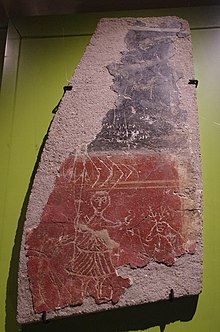 Fragment of a plaster wall from a dwelling inscribed with graffiti including the goddess Diana and a stag. Image shows the graffiti, dating from the 2nd century to AD 275, on display in the Roman Museum at Augusta Raurica | |
| Language | Latin |
|---|---|
| Geographical range | Roman Empire |
| Period | Ancient Rome |
| Major sites | Pompeii |
In archaeological terms, graffiti (plural of graffito) is a mark, image or writing scratched or engraved into a surface.[1] There have been numerous examples found on sites of the Roman Empire, including taverns and houses, as well as on pottery of the time. In many cases the graffiti tend toward the rude, with a line etched into the basilica in Pompeii reading "Lucilla made money from her body," phallic images, as well as erotic pictures.[2] Other graffiti took on a more innocent nature, taking the form of simple pictures or games.[3] Although many forms of Roman graffiti are indecipherable, studying the graffiti left behind from the Roman Period can give a better understanding of the daily life and attitudes of the Roman people with conclusions drawn about how everyday Romans talked, where they spent their time, and their interactions within those spaces.
- ^ Knapp, Robert C. (2011). Invisible Romans. Cambridge, Mass: Harvard UP.
- ^ Mount, Harry (1 October 2013). "What Can We Learn from Roman Graffiti?". The Telegraph'. Telegraph Media Group. Archived from the original on 1 October 2013. Retrieved 3 November 2015.
- ^ Hoff, Michael (2006). "Some Inscribed Graffiti in the Roman Market in Athens". Zeitschrift für Papyrologie und Epigraphik. 155: 176–182. JSTOR 20191037.